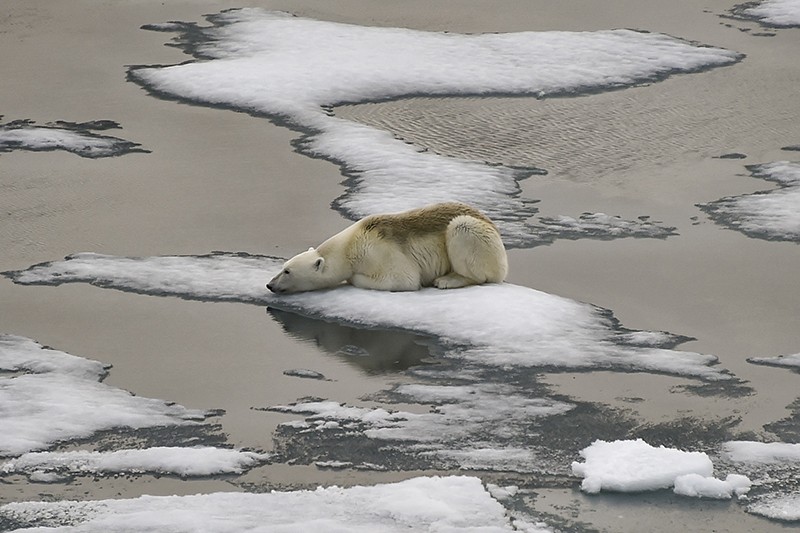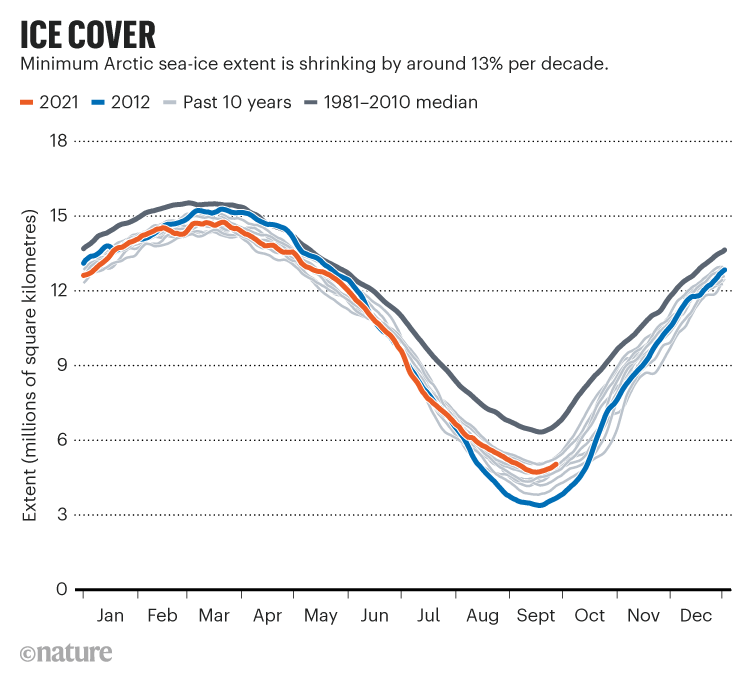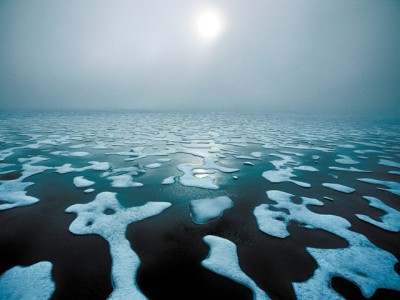This summer’s minimum ice cover was twelfth-lowest ever — and scientists warn that the long-term trend towards shrinking continues.
Tosin Thompson

Arctic animals such as polar bears rely on sea ice. Although this year’s annual minimum extent was relatively high, ice cover is shrinking as global temperatures rise
Credit: Ekaterina Anismova/AFP via Getty
Arctic sea ice has passed its minimum extent for this year, shrinking to 4.72 million square kilometres on 16 September, the US National Snow and Ice Data Center (NSIDC) has reported.
Owing to a cool and cloudy Arctic summer, this year’s annual minimum was the highest since 2014 — ice covered nearly 1 million square kilometres more than last year’s extent of 3.82 million square kilometres, which was the second-lowest ever observed (see ‘Ice cover’). But it is still the twelfth-lowest sea-ice extent in nearly 43 years of satellite recordings, and scientists say that the long-term trend is towards lower ice cover.
“Even with global warming and the overall downward trend in sea ice, there is still natural variability,” says Walt Meier, a senior research scientist at NSIDC, who is based at the University of Colorado Boulder.

Source: NSIDC
The minimum Arctic sea-ice extent is declining at a rate of 13.1% per decade. “Including this year, the last 15 years have had the 15 lowest minimum Arctic extents on record,” Meier says. The lowest minimum extent on record was set in 2012, after a very strong storm sped up the loss of thin ice that was already on the verge of melting.
“The average of all the years is steadily decreasing while the average global mean temperature is increasing,” says Steven Amstrup, chief scientist of Polar Bears International in Bozeman, Montana. He adds that, although there might be higher sea-ice extents in any given year, the frequency of “bad” ice years with a low minimum sea-ice extent is increasing. “Better ice years are increasingly anomalous in the long-term trend,” Amstrup says.
A cool summer
Arctic regions experienced a cooler, cloudier summer season than usual this year, which was partly caused by patterns of low atmospheric pressure in the Northern Hemisphere.

Arctic 2.0: What happens after all the ice goes?
In June and July, weak low pressure in the central Arctic prevented warmer, southern winds from being drawn into the area. This kept the air cold and stopped some of the ice from melting. Low pressure also causes the formation of clouds, which block sunlight. This can further slow down melting.
In August, the low-pressure system shifted to the north of Alaska’s Beaufort and Chukchi Seas, producing air temperatures that were 2—3 °C lower than average. And last year’s winter winds had pushed older, thicker ice into both seas. “So going into the summer, the ice there was thicker than it had been in recent years, and that made it a bit more resilient,” says Meier. “However, there is also likely a climate-change aspect,” he adds. “There is less older ice overall and the ice cover is thinner. Thinner ice is more easily pushed around by the winds and currents.”
A transient increase in sea ice might create better conditions for species that use the ice to hunt, says Amstrup. “But it’s that downward trend of ice sea, caused by an increasing frequency of bad ice years, that determines the ultimate fate of polar bears and other sea-ice-dependent wildlife.”
doi: https://doi.org/10.1038/d41586-021-02649-6
Arctic sea ice has passed its minimum extent for this year, shrinking to 4.72 million square kilometres on 16 September, the US National Snow and Ice Data Center (NSIDC) has reported.
Owing to a cool and cloudy Arctic summer, this year’s annual minimum was the highest since 2014 — ice covered nearly 1 million square kilometres more than last year’s extent of 3.82 million square kilometres, which was the second-lowest ever observed (see ‘Ice cover’). But it is still the twelfth-lowest sea-ice extent in nearly 43 years of satellite recordings, and scientists say that the long-term trend is towards lower ice cover.
“Even with global warming and the overall downward trend in sea ice, there is still natural variability,” says Walt Meier, a senior research scientist at NSIDC, who is based at the University of Colorado Boulder.

Source: NSIDC
The minimum Arctic sea-ice extent is declining at a rate of 13.1% per decade. “Including this year, the last 15 years have had the 15 lowest minimum Arctic extents on record,” Meier says. The lowest minimum extent on record was set in 2012, after a very strong storm sped up the loss of thin ice that was already on the verge of melting.
“The average of all the years is steadily decreasing while the average global mean temperature is increasing,” says Steven Amstrup, chief scientist of Polar Bears International in Bozeman, Montana. He adds that, although there might be higher sea-ice extents in any given year, the frequency of “bad” ice years with a low minimum sea-ice extent is increasing. “Better ice years are increasingly anomalous in the long-term trend,” Amstrup says.
A cool summer
Arctic regions experienced a cooler, cloudier summer season than usual this year, which was partly caused by patterns of low atmospheric pressure in the Northern Hemisphere.

Arctic 2.0: What happens after all the ice goes?
In June and July, weak low pressure in the central Arctic prevented warmer, southern winds from being drawn into the area. This kept the air cold and stopped some of the ice from melting. Low pressure also causes the formation of clouds, which block sunlight. This can further slow down melting.
In August, the low-pressure system shifted to the north of Alaska’s Beaufort and Chukchi Seas, producing air temperatures that were 2—3 °C lower than average. And last year’s winter winds had pushed older, thicker ice into both seas. “So going into the summer, the ice there was thicker than it had been in recent years, and that made it a bit more resilient,” says Meier. “However, there is also likely a climate-change aspect,” he adds. “There is less older ice overall and the ice cover is thinner. Thinner ice is more easily pushed around by the winds and currents.”
A transient increase in sea ice might create better conditions for species that use the ice to hunt, says Amstrup. “But it’s that downward trend of ice sea, caused by an increasing frequency of bad ice years, that determines the ultimate fate of polar bears and other sea-ice-dependent wildlife.”
doi: https://doi.org/10.1038/d41586-021-02649-6
No comments:
Post a Comment